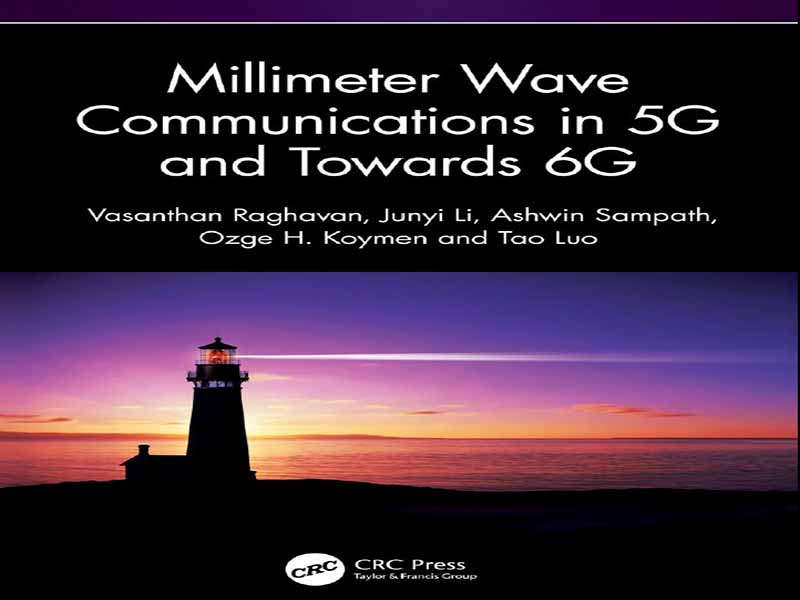- عنوان کتاب: Millimeter Wave Communications in 5G and Towards 6G
- نویسنده: Vasanthan Raghavan
- حوزه: الکترومغناطیس
- سال انتشار: 2025
- تعداد صفحه: 298
- زبان اصلی: انگلیسی
- نوع فایل: pdf
- حجم فایل: 8.03 مگابایت
تمرکز این کتاب بر توضیح جنبههای مختلف سیستمهای موج میلیمتری (mmWave) است. این سیستمها امروزه یکی از اجزای اصلی شبکههای سلولی نسل پنجم (5G) را تشکیل میدهند و ستون اصلی سیستمهای نوظهور نسل ششم (6G) و پس از آن باقی خواهند ماند. به طور دقیق، رژیم mmWave به سیستمهایی اطلاق میشود که در رژیم فرکانسی مربوط به طول موجهای میلیمتری (30 تا 300 گیگاهرتز) کار میکنند. در عمل، در سطح پروژه مشارکت نسل سوم (3GPP)، رژیم mmWave به عنوان محدوده فرکانسی 2 (FR2) مشخص میشود و مخفف رژیم 24.25 تا 71 گیگاهرتز است. گسترشهای FR2 شامل محدوده فرکانسی 4 (FR4) با تمرکز بر 71 تا 114.25 گیگاهرتز و محدوده فرکانسی 5 (FR5) با تمرکز بر فرکانسهای فراتر از 114.25 گیگاهرتز است. جنبههای مختلف طراحی سیستمهای FR2 همچنین بر طراحی سیستمهای محدوده فرکانسی 3 (FR3) با تمرکز بر 7.125 تا 24.25 گیگاهرتز تأثیر میگذارد، که با تکامل 6G از منظر طیف موجود، از اهمیت بالایی نیز برخوردارند. طیف FR2 و به طور کلیتر، سیستمهای mmWave تا آغاز فرآیند استانداردسازی 5G به دلایل مختلف توجه مهندسان بیسیم شاغل را به خود جلب نکردند. برخی از این دلایل عبارتند از: • کمبود طیف مجاز در FR2 برای عملیات سلولی • پیچیدگیهای طراحی سطح دستگاه اجزای فرکانس رادیویی (RF) و هزینههای بالای آنها، مساحت و مصرف توان و همچنین مدیریت حرارتی مرتبط با مصرف توان بالاتر • بودجههای لینک ضعیف که منجر به عملیات سلولی کوچک مربوط به فواصل بین سایتی (ISD) 200 تا 500 متر در مقایسه با پوشش 1 تا 3 کیلومتری برای سیستمهای نسل سوم/چهارم (3G/4G) میشد • افزایش هزینههای سرمایهای (Capex) و عملیاتی (Opex) مرتبط با استقرار این سلولهای کوچک • لزوم شکلدهی پرتو چند آنتنی در سطح RF برای پر کردن بودجه لینک، که مستلزم پیشرفت در طراحی آرایه آنتن، طراحی تراشه مدار مجتمع فرکانس رادیویی (RFIC) و فناوریهای بستهبندی است • فقدان یک طراحی لایه فیزیکی سیستماتیک که از ویژگیهای منحصر به فرد مرتبط با این فرکانسها بهره ببرد و با اختلالات آنها مقابله کند. در طول ده سال گذشته، سیستمهای بیسیم mmWave شاهد انقلاب عظیمی بودهاند که از گزارشهای رسمی و اسناد چشمانداز آغاز شده و به نمونههای اولیه آزمایشی و تلاشهای پیش از استانداردسازی 5G منجر شده و به دنبال آن فرآیند استانداردسازی نسل پنجم رادیو جدید (5GNR) برای نسخه 15 (Rel. 15) در 3GPP انجام شده است. این امر منجر به طراحی، توسعه و تکامل مودمهای سازگار با 5G-NR مانند خانوادههای مودم Snapdragon®1 X50، X55، X60، X65، X70 و X75 از Qualcomm Technologies شده است. این تحولات به طور موازی منجر به تکامل مشخصات 3GPP در نسخه 16 و فراتر از آن شده است. با توجه به این پیشینه، این کتاب به بررسی، بررسی و رفع ابهام از مسائل اساسی پشت فناوری mmWave میپردازد. خواهیم دید که این تکامل را میتوان به عنوان یک پیوستار در نظر گرفت که با انقلاب چند ورودی چند خروجی (MIMO) که ستون فقرات سیستمهای 3G و 4G را تشکیل میدهد، و همچنین سری استانداردهای 802.11 موسسه مهندسان برق و الکترونیک (IEEE) برای سیستمهای WiFi آغاز میشود. در این مرحله، تعدادی کتاب [1، 2، 3، 4] منتشر شده است که به موضوعاتی مانند 5G، ارتباطات گسترده MIMO و mmWave از جمله جزئیات مشخصات و توافقنامههای استانداردسازی 5G-NR میپردازند. این کتاب از جنبههای زیر با دسته کتابهای فوق متفاوت است. این کتاب با هدف صریح توضیح چگونگی توسعه و تکامل تحقیقات mmWave نوشته شده است. این کتاب اصول اساسی زیربنای پردازش سیگنال و عوامل تعیینکننده فناوری و به طور دقیقتر، چرایی؟ پشت چیستی؟ که مشخصات 5G-NR را تشکیل میدهند، توضیح میدهد. همچنین توسط نظریهپردازانی نوشته شده است که ریشه در صنعت بیسیم دارند و تجربه دانشگاهی و صنعتی قابل توجهی دارند. موضوع این کتاب مربوط به بدهبستانهای بین طرحهای مختلف پیشکدگذاری و شکلدهی پرتو در MIMO موج میلیمتری (mmWave MIMO) و چگونگی تأثیر منحصر به فرد آنها بر محدودیتهای سطح دستگاه (در سطوح RF و آنتن) مانند هزینه، پیچیدگی، مساحت، مصرف انرژی، ساختار کانال، افزایش عملکرد و غیره است. هدف این کتاب کمک به خواننده در درک دامنه و مقیاس پیچیدگیهای موجود در طراحی تجهیزات کاربر (UE) و تجهیزات محل مشتری (CPE)، چگونگی تلاش فرآیند استانداردسازی برای رفع این پیچیدگیها و اثربخشی راهحلهای مطرحشده توسط تلاشهای استانداردسازی است. با خواندن این کتاب، میتوان فهمید که مفاهیم فناوری موج میلیمتری چگونه در سیستمهای دسترسی بیسیم موبایل و ثابت به کار گرفته میشوند. علاوه بر این، میتوان با تمرکز بر ملاحظات استقرار عملی، نحوه عملکرد آنها را درک کرد.
The focus of this book is on explaining different facets of millimeter wave (mmWave) systems. These systems form one of the core components of Fifth Generation (5G) cellular networks today and will remain a central pillar of the emerging Sixth Generation (6G) systems and beyond. Strictly speaking, the mmWave regime stands for systems that operate at a frequency regime corresponding to millimeter wavelengths (30–300 GHz). In practice, at the Third Generation Partnership Project (3GPP) level, the mmWave regime is denoted as Frequency Range 2 (FR2) and stands for the 24.25–71 GHz regime. Extensions to FR2 include Frequency Range 4 (FR4) focusing on 71–114.25 GHz and Frequency Range 5 (FR5) focusing on beyond 114.25 GHz frequencies. Different design aspects of FR2 systems also impact the design of Frequency Range 3 (FR3) systems focusing on 7.125–24.25 GHz, which are also of broad importance as 6G evolves from an available spectrum perspective. FR2 spectrum and more broadly mmWave systems did not attract attention from practicing wireless engineers till the beginning of the 5G standardization process due to a number of reasons. Some of these reasons included: • Lack of licensed spectrum in FR2 for cellular operations • Device level design complexities of radio frequency (RF) components and their high cost, area and power consumption profiles as well as the thermal management associated with higher power consumption • Poor link budgets that implied a small cell operation corresponding to 200– 500 meter inter-site distances (ISDs) in contrast to the 1–3 km coverage for Third/Fourth Generation (3G/4G) systems • Increased capital expenses (Capex) and operational expenses (Opex) associated with the deployment of these small cells • Necessity of multi-antenna beamforming at the RF level to bridge the link budget, requiring advances in antenna array design, radio frequency integrated circuit (RFIC) chip design and packaging technologies • Lack of a systematic physical layer design that would take advantage of the unique features associated with these frequencies and combat their impairments. Over the last ten years, mmWave wireless systems have seen a massive revolution starting from white-papers and vision documents leading to experimental prototypes and pre-5G standardization efforts followed by the Fifth Generation-New Radio (5GNR) standardization process for Release 15 (Rel. 15) at 3GPP. This led to the design, development, and evolution of 5G-NR compliant modems such as the Snapdragon®1 X50, X55, X60, X65, X70 and X75 modem families from Qualcomm Technologies. These developments have in parallel led to the evolution of the 3GPP specifications in Rel. 16 and beyond. Given this background, this book addresses, explores and demystifies the fundamental issues behind mmWave technology. We will see that the evolution can be seen as a continuum that starts with the multiple-input multipleoutput (MIMO) revolution that forms the backbone of 3G and 4G systems, as well as the Institute of Electrical and Electronics Engineers (IEEE) 802.11 series of standards for WiFi systems. At this stage, there are a number of books [1, 2, 3, 4] that have been published which address topics such as 5G, massive MIMO and mmWave communications including details on the 5G-NR standardization specifications and agreements. This book differs from the above class of books in the following aspects. This book is written with the express goal of explaining how the mmWave research developed and evolved. It explains the fundamental principles beneath the signal processing and technology determinants and more precisely, the Why? behind the What? that make the 5G-NR specifications. It is also written by theoreticians firmly grounded in the wireless industry and with significant academic and industrial experience. The subject matter of this book concerns the tradeoffs between different possible mmWave MIMO precoding and beamforming schemes, and how they are uniquely impacted by device level constraints (at the RF and antenna levels) such as cost, complexity, area, energy consumption, channel structure, performance gains, etc. The aim of this book is to help the reader understand the scope and scale of complexities involved in form factor user equipment (UE) and customer premises equipment (CPE) design, how the standardization process tries to address these complexities, and the efficacy of the solutions addressed by the standardization efforts. Upon reading this book, one can understand how mmWave technology concepts are applied in mobile and fixed wireless access systems. Further, one can understand how they perform with a focus on practical deployment considerations.
این کتاب را میتوانید از لینک زیر بصورت رایگان دانلود کنید:
Download: Millimeter Wave Communications in 5G and Towards 6G




































نظرات کاربران